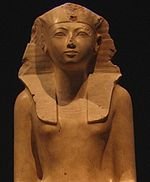Hatshepsut, Metropolitan Museum of Art
 In ancient Egypt the familial connections were very creative and unusual, and this gets a little confusing here but stick with me. Thutmosis ll was king just prior to 1500 BC. When he died his son, Thutmosis lll, automatically became king, although he was still an infant. Hatshepsut who was the baby’s aunt and stepmother, then married him, and they ruled together for over 20 years as co-regents. Being the strong personality that she was, Hatshepsut pushed the young Thutmosis to the background and ruled Egypt as pharaoh on her own. This tended to irk everyone around because it was not customary for women to be pharaoh.
In ancient Egypt the familial connections were very creative and unusual, and this gets a little confusing here but stick with me. Thutmosis ll was king just prior to 1500 BC. When he died his son, Thutmosis lll, automatically became king, although he was still an infant. Hatshepsut who was the baby’s aunt and stepmother, then married him, and they ruled together for over 20 years as co-regents. Being the strong personality that she was, Hatshepsut pushed the young Thutmosis to the background and ruled Egypt as pharaoh on her own. This tended to irk everyone around because it was not customary for women to be pharaoh.
To add to this colorful story, Hatshepsut, for the first few years remained queen and used titles such as King’s Chief Wife, God’s Wife, and Mistress of the Two Lands. But later she took on the full personality of king and began to wear masculine clothes and other accoutrement’s. Some historians have intimated Hatshepsut was a transvestite because of this. Others have speculated she was perceived as such merely because “kings should be male” and artisans projected her as a male in the paintings and statues.
After her death at about age 36, her body was never found, and it was thought she was assassinated. However, it seems now her body has been found and there is an extensive story about this in the April, National Geographic. Since hearing about this article, I ordered that issue and will be continuing this story in a later post.
